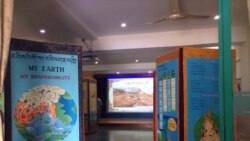Empowered by a curriculum developed by the U.S. Agency for International Development Lowering Emissions in Asia’s Forests (USAID LEAF) program, 700 professors at 63 universities in the Asia-Pacific region are rolling out education to a new generation of climate change professionals in Southeast Asia.
Working with university professors mainly from the Lower Mekong region, USAID LEAF and the United States Forest Service designed the curriculum to cover basic climate change, social and environmental soundness, low emission land use planning and carbon measurement and monitoring. The curriculum is adapted to specific country contexts, and is already being used in classrooms to teach more than 30,000 undergraduate and 700 graduate students.
“It’s easier for me to prepare lessons because the material is ready to use,” said Mrs. Somvilay Chanthalounnavong, who teaches at the National University of Laos. “There are examples, case studies and guides for the instructor about how to explain the concepts and how to use the material, including role plays, questions and answers and quizzes.”
The curriculum also works well at Thai universities. “If you show scientific evidence for climate change, students really get it,” said Dr. Pimonrat Tiansawat [pee-moan-RAHT tee-AN-swaht] from Chiang Mai University. “They get excited when I talk about ice cores and tree rings. They see the evidence and are more engaged."
Forests cover about 26 percent of the Asia-Pacific region providing livelihoods for local communities and environmental benefits such as reducing carbon and conserving biodiversity. Forests help reduce the negative effects of climate change by storing carbon and greenhouse gas emissions, but the region is experiencing a high rate of forest degradation and deforestation from agricultural expansion, unsustainable logging, urbanization and other factors.
“Taking climate change to classrooms in the region today is a powerful way to ensure that tomorrow’s leaders are already thinking about forests and the environment,” said Beth Paige, director for USAID’s Regional Development Mission in Asia, on the occasion of the International Day of Forests. “We need the energy and drive of intelligent, innovative youth to lock in climate change on national and regional agendas. That’s our collective hope for the future of our planet.”

















